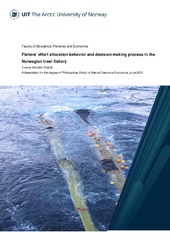Fisher's effort allocation behavior and decision-making process in the Norwegian trawl fishery
Permanent link
https://hdl.handle.net/10037/21226Date
2021-06-09Type
Doctoral thesisDoktorgradsavhandling
Author
Alizadeh Ashrafi, TannazAbstract
The empirical investigation of fishers’ harvest behavior is an important but neglected strand of fishery science. In this thesis, we fill some of this gap by developing empirical models to investigate trawlers’ harvest behavior over time and space in codfish fisheries, managed using individual vessel quotas (IVQs).
Fishers’ harvest behavior is reflected in the decision-making processes underlying effort allocation: when and where to fish, what species to target, and how much to fish in each haul to avoid over- and underutilization of quotas. Effort allocation is a challenging task, especially in multi-species fisheries as the fish stocks in the fishing portfolio may differ in feeding, breeding, and migration patterns. This biological heterogeneity together with constant movement of different fish stocks across various locations influences economic conditions such as market prices and operation costs. What adds more complication to optimal allocation of fishing effort is the constantly changing environmental conditions such as food availability and sea temperature, which influence fish behavior. Another complication arises from the inherent uncertainties and external disturbances such as abrupt oceanographic changes, which affect the catch size and profitability. On top of what has been mentioned, institutional regulations such as quota restrictions further complicate the decisions underlying effort allocation.
Understanding how trawlers behave and why they behave the way they do reveals valuable information about marine resource status, as well as evaluating fisheries management options to anticipate the possible responses of fishers to changing regulatory schemes. Moreover, recognition of the fishing effort allocation of the trawl fleet enables fisheries managers to evaluate the status of the benthos and seafloor as dragging heavy nets across the ocean can be environmentally destructive.
This thesis focuses on codfish; that is, cod, saithe, and haddock fisheries as this portfolio includes economically important species in terms of volume and total revenue. These fish species are seasonally migratory and constantly swim over a vast geographical area to spawn and/or feed. The thesis aims to empirically investigate the fishing behavior of Norwegian trawlers in response to the economic changes stemming from the migratory behavior of these fish stocks, and to show how this could affect harvest attributes such as location choice, timing of production, preference in target species, and quota utilization.
This study employs and combines multiple data sources for the empirical analysis of spatiotemporal allocation of fishing effort in trawl fishery. Our comprehensive data set covers the relevant information of trawl fishery during 2011–2016 to conduct empirical investigations of trawlers’ adopted harvest strategy and explain the drivers behind the chosen harvest strategy. The outcomes of this thesis are believed to be useful to fisheries managers in the policy-making process as well as for fishers’ communities to enhance the efficiency of their fishing activities.
Has part(s)
Paper 1: Alizadeh Ashrafi, T., Eide, A. & Hermansen, Ø. Spatial and temporal distributions in the Norwegian Cod fishery. (Manuscript). Now published in Natural Resource Modeling, 33(4), 2020, e12276. Available in Munin at https://hdl.handle.net/10037/19268.
Paper 2: Alizadeh Ashrafi, T., Syed, S. & Eide, A. Individual quotas and revenue risk of fishing portfolio in the trawl fishery. (Manuscript). Now published in Fisheries Research, 241, 2021, 105990. Available at https://doi.org/10.1016/j.fishres.2021.105990.
Paper 3: Alizadeh Ashrafi, T. & Abe, K. Intra and inter-temporal effort allocation and profit maximizing strategy of the trawl fishery. (Submitted manuscript).
Publisher
UiT The Arctic University of NorwayUiT Norges arktiske universitet
Metadata
Show full item recordCollections
Copyright 2021 The Author(s)
The following license file are associated with this item:


 English
English norsk
norsk
